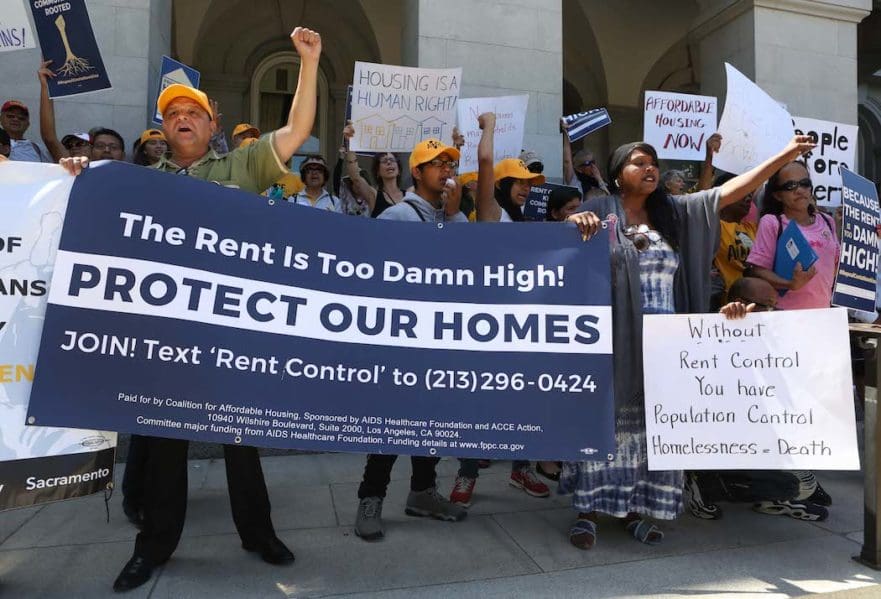California’s housing affordability crisis is devastating the middle- and working-class. It’s an emergency that’s impacting millions—and unfolding right now. We need urgent solutions. Housing Is A Human Right, the housing advocacy division of AIDS Healthcare Foundation, urges local and state legislators to implement rent control policies.
The real estate industry and certain politicians and academics will say that addressing the housing affordability crisis is simply a matter of supply and demand. Their solution? Build more luxury housing to address a crisis of affordability. It makes little sense — and fuels gentrification and displacement. But it’s a convenient, trickle-down economics argument that will generate billions in revenue for the real estate industry, who are major campaign contributors to local and state legislators. We can’t continue this flawed, harmful, greedy approach.
Dr. Stephen Barton, former housing director for the city of Berkeley and co-author of an important paper on rent control published through UC Berkeley, noted: “When the housing market is as dysfunctional as it is in many parts of California, tenants are effectively subsidizing landlords with rent payments above what a fully competitive market would allow landlords to charge.”
Over the years, a growing body of research has recognized that modern rent stabilization policies benefit not just tenants but also promote neighborhood stability and diversity more broadly. Just last year, studies from USC, UCLA, and UC Berkeley found that rent control is a key tool to stabilize our communities and bring immediate relief to teachers, fixed-income seniors, families, recent college graduates, and many others.
“The housing crisis requires a range of strategies, [and] moderate rent regulation is a useful tool to be nested in broader strategy,” wrote USC Professor Manuel Pastor, co-author of a highly regarded report titled Rent Matters. “It has fewer damaging effects than are often imagined, it can address economic pain, and it can promote housing stability. And housing stability matters because it is associated with physical, social, and psychological well-being; higher educational achievement by the young; and benefits for people of color.”
In 2018, Proposition 10, which sought to repeal severe rent control restrictions in California, lost statewide. But a broad coalition of more than 525 organizations and civic leaders, including U.S. Senator Bernie Sanders, the California Labor Federation, and the California Teachers Association, endorsed the measure. Also, the initiative received a majority of support from voters living in California cities that are getting slammed by unfair, excessive rents. It won in Los Angeles, San Francisco, Pasadena, Oakland, Berkeley, Inglewood, Pasadena, Santa Monica, and other cities where people are bearing the brunt of skyrocketing rents and who desperately need help.
The housing affordability crisis is a global phenomenon exacerbated by increased speculation in the housing market and sluggish, long-term wage growth. A tidal wave of investor money in housing markets is contributing to accelerating prices, making it all but impossible for people to buy or rent their homes.
While median rents rose by an inflation-adjusted 61 percent between 1960 and 2016, the median renter’s income grew a meager 5 percent. One in four renter households have extremely low incomes, while the average cost of housing is nearly twice what many households can endure. According to The Pew Charitable Trusts, nearly 40 percent of all renter households in the U.S. are “rent burdened,” paying more than what federal guidelines consider affordable as a share of their income. Still worse, 17 percent of renter households are “severely rent burdened,” spending at least half of their income on rent. California renters are among the hardest hit by excessive rents.
In other words, the middle- and working-class are facing a housing affordability disaster.
It is no wonder, then, that legislators from California to Florida are revisiting the need for stronger protections to keep people in their homes. Housing Is A Human Right, in fact, promotes a multi-pronged approach to fix our housing affordability crisis: the “3 Ps.” We must protect tenants through rent control and other policies; preserve existing affordable housing such as rent-controlled units; and produce truly affordable housing.
Earlier this month, Oregon became the first state to pass some form of statewide rent regulations. Although the Oregon law is insufficient, with their rent ceiling far exceeding inflation, it suggests a renewed appetite to counter speculative housing costs with greater tenant protections. California lawmakers must go beyond the Oregon law’s provisions given the severity of the crisis in many of our communities.
Trickle-down housing policies pushed by politicians such as California State Sen. Scott Wiener, who’s pushing the trickle-down housing bill SB 50, fail the middle- and working-class. We need a multi-pronged, people-first agenda to urgently address our housing affordability crisis, with rent control at its core. Rent control is one of the fastest, most effective, most popular, and most broad-based tools to stabilize the lives of millions of Californians. Our legislators must make use of it.
The author, René Christian Moya, is the director of Housing Is A Human Right.

